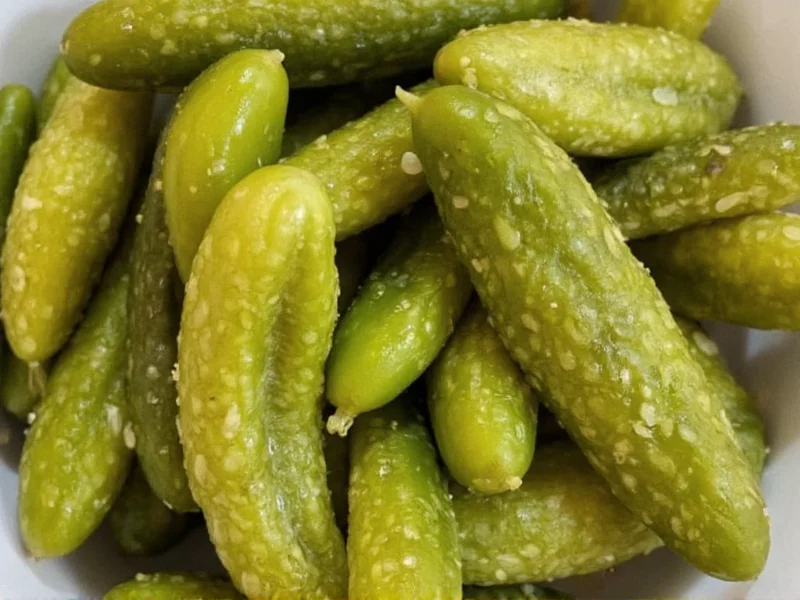Understanding whether pickles count as fermented foods requires examining both traditional preparation methods and modern manufacturing processes. The answer isn't as straightforward as many assume, as the term "pickle" encompasses both fermented and non-fermented varieties.
The Science Behind Fermentation
Fermentation occurs when microorganisms like bacteria, yeast, or fungi convert carbohydrates to alcohol or organic acids under anaerobic conditions. In the case of traditional pickles, lacto-fermentation is the specific process where Lactobacillus bacteria transform cucumber sugars into lactic acid. This natural preservation method creates the characteristic tangy flavor while extending shelf life.
Traditional Fermented Pickles vs. Vinegar-Based Pickles
Historically, all pickles were fermented. The traditional method involves:
- Submerging cucumbers in a saltwater brine (typically 2-5% salt solution)
- Allowing natural bacteria to ferment the cucumbers at room temperature for 1-6 weeks
- Storing the finished product in a cool environment
In contrast, most supermarket pickles use a quicker vinegar-based method:
- Cucumbers are submerged in a solution of vinegar, water, and salt
- Heat is often applied to accelerate flavor absorption
- The process takes days rather than weeks
| Characteristic | Fermented Pickles | Vinegar-Based Pickles |
|---|---|---|
| Production Method | Lacto-fermentation with salt brine | Vinegar soaking |
| Time Required | 1-6 weeks | Hours to days |
| Probiotic Content | Rich in live beneficial bacteria | No live probiotics |
| Flavor Development | Complex, evolving flavors | Immediate, consistent sourness |
| Common Label Terms | "Naturally fermented," "raw," "unpasteurized" | "Vinegar pickles," "fresh pack" |
How to Identify Truly Fermented Pickles
When shopping for fermented pickles, look for these indicators:
- Refrigerated section - Truly fermented pickles require cold storage to maintain live cultures
- Ingredients list containing only cucumbers, water, salt, and sometimes spices (no vinegar)
- Label claims like "naturally fermented," "contains live cultures," or "unpasteurized"
- Absence of preservatives like sodium benzoate or calcium chloride
Many commercial brands misleadingly use the term "fermented" while actually using vinegar. Always check the ingredients rather than relying solely on marketing language when determining how to tell if pickles are fermented.
Health Implications: Fermented vs. Vinegar Pickles
The health benefits of fermented pickles differ significantly from their vinegar-based counterparts:
Authentic fermented pickles provide:
- Naturally occurring probiotics that support gut health
- Enhanced nutrient bioavailability
- Production of beneficial compounds like bacteriocins
- Potential immune system support
Vinegar-based pickles offer:
- Acetic acid benefits (modest blood sugar regulation)
- No live microbial cultures
- Faster production but less complex flavor development
Research shows that the probiotic content in fermented pickles can vary significantly based on fermentation time, temperature, and salt concentration. Longer fermentation periods generally produce more diverse microbial communities and greater potential health benefits.
Common Misconceptions About Pickles and Fermentation
Several misunderstandings persist about are dill pickles fermented and related topics:
Misconception: All pickles are fermented
Reality: Most store-bought pickles use vinegar rather than fermentation
Misconception: "Fermented" on the label guarantees live cultures
Reality: Some products undergo pasteurization after fermentation, killing beneficial bacteria
Misconception: Fermented pickles taste radically different from vinegar pickles
Reality: Many fermented pickles develop similar flavor profiles through natural acid production
Making Your Own Fermented Pickles
Creating authentic traditional fermented pickle recipe at home ensures you get true fermented benefits. The basic process involves:
- Selecting fresh, unwaxed cucumbers (Kirby varieties work best)
- Preparing a 3-5% saltwater brine (30-50g salt per liter of water)
- Adding flavorings like dill, garlic, mustard seeds, or peppercorns
- Submerging cucumbers completely in brine (use fermentation weights)
- Allowing to ferment at 65-75°F (18-24°C) for 1-6 weeks
- Transferring to cold storage when desired flavor is achieved
During fermentation, you'll notice bubbles forming and the brine becoming cloudy—these are signs of active microbial activity. The flavor will evolve from mild to increasingly tangy over time.











 浙公网安备
33010002000092号
浙公网安备
33010002000092号 浙B2-20120091-4
浙B2-20120091-4